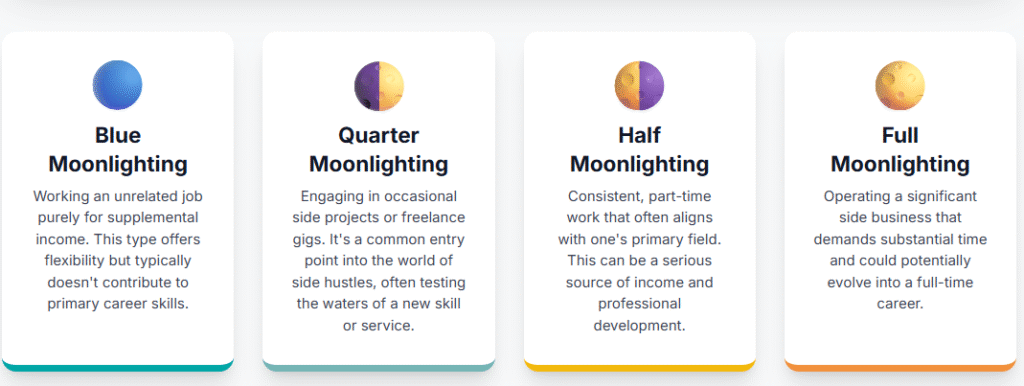Let’s be honest — one job doesn’t always feel like enough anymore.
Between rising living costs, creative ambitions, and the flexibility of remote work, many professionals are finding themselves drawn to something outside their 9-to-5. Maybe it’s a freelance project, a passion turned side hustle, or just a way to earn a little extra on the weekends.
This growing reality has a name: moonlighting.
What used to be a quiet side gig is now part of how we navigate modern work. But along with the freedom comes confusion — is it allowed? Is it ethical? Could it risk your current job?
In this blog, we’re taking a closer look at moonlighting: what it means today, why it’s on the rise, and how both employees and employers can approach it with clarity and confidence.
Because in 2025, moonlighting isn’t just a trend — it’s a reflection of how work is evolving.
What is Moonlighting?
Moonlighting is when an individual takes on additional jobs or freelance work alongside their primary employment. For instance, an IT professional working full-time at a tech company may freelance as a web developer in the evenings.
The term “moonlighting” originated from the idea of working a second job at night (under the “moonlight”) after regular working hours.
Why Moonlighting is Gaining Popularity in 2025
The trend of moonlighting has surged post-pandemic due to several key factors:
- Gig Economy Rise: Post-pandemic normalization of gig work and flexible employment.
- Economic Pressures: Rising inflation and living costs pushing individuals to seek additional income.
- Remote Work: Easier for employees to juggle multiple income streams due to remote work flexibility.
- Gen Z Influence: Younger generations seeking careers aligned with passion projects and financial independence.
“Approximately 64% of Gen Z professionals actively pursue side hustles for financial freedom and career exploration.” – LinkedIn Workforce Report 2025
Types of Moonlighting

Ethical vs Unethical Moonlighting
Not all moonlighting is frowned upon. In fact, many employers are open to it — as long as it doesn’t compromise company interests.
Ethical moonlighting means you’re transparent with your employer (if required), you don’t use office time or resources, and your side gig doesn’t compete with your main job. It’s about balance and respect.
Unethical moonlighting, however, occurs when employees:
- Work for direct competitors
- Use proprietary information
- Miss deadlines or underperform at their main job
- Hide the side work despite clear contract restrictions
The line is fine, but crucial. Transparency is key.
Moonlighting vs Freelancing vs Gig Work
Though they often overlap, there are subtle differences between moonlighting, freelancing, and gig work.
- Moonlighting involves taking up side work in addition to a full-time job. It’s often hidden from the employer, depending on the contract.
- Freelancing is typically independent, flexible, and usually full-time or part-time without a primary employer.
- Gig work refers to task-based jobs, often short-term, through platforms like Fiverr, Uber, or TaskRabbit.
The biggest issue with moonlighting is conflict of interest. If you freelance or gig in a way that competes with your main job — legally or ethically — that’s when problems arise.
Legal Status of Moonlighting Around the World
Legal status depends largely on geography and employer policy.
In India, moonlighting isn’t illegal, but dual employment is discouraged in formal sectors. If your EPFO (Employees’ Provident Fund) account shows multiple active employers, it could raise red flags. Many companies now track dual employment via UAN (Universal Account Number) activity.
In the United States, moonlighting is allowed unless it violates employment contracts. It’s common among creatives, healthcare workers, and IT professionals.
The UK allows moonlighting, provided it doesn’t exceed working hour limits or breach contracts.
Across Europe, labor laws vary, but most countries allow secondary employment with certain working hour restrictions.
In Singapore, dual employment is legal, but permission is typically required from your primary employer, especially in regulated sectors.
To avoid legal complications, always check local labor laws and your employment agreement.
Why Employees Choose to Moonlight
People moonlight for many reasons — and it’s rarely just about money.
Some are trying to supplement their income, especially with rising living costs. Others want to explore a new career path while maintaining the safety net of their current job. For many, moonlighting is about upskilling — testing their abilities in new roles without taking a full leap.
There’s also a growing group of professionals who feel disengaged or undervalued at their primary workplace. Moonlighting becomes their creative or professional outlet — and often, the beginning of entrepreneurial journeys.
What Moonlighting Impacts Employers
From an employer’s perspective, moonlighting can be a mixed bag.
On one hand, employees taking initiative and seeking growth can be a good sign. On the other, unchecked moonlighting may lead to:
- Productivity loss, as focus is divided
- Confidentiality breaches, especially in competitive industries
- Client overlap or poaching, where boundaries blur
- Burnout, leading to absenteeism or disengagement
For companies, the challenge is managing trust without micromanaging — and creating an environment where employees don’t feel the need to look elsewhere.
How Companies Detect Moonlighting
In India, UAN-based tracking is gaining traction. Employers can check if an employee is drawing PF from more than one company.
Other tactics include:
- Monitoring LinkedIn, GitHub, or Upwork profiles
- Background verification (BGV) during job switches
- Watching for sudden performance drops or increased absenteeism
While companies may track activity, surveillance must comply with local labor and privacy laws.
How Employers Can Address Moonlighting
The best defense isn’t always legal. It’s cultural.
Start by creating a clear Moonlighting Policy that outlines:
- What kind of side work is allowed
- How and when it must be disclosed
- Consequences for violating policy
Beyond documentation, employers can:
- Offer mental health support and reasonable workloads
- Acknowledge employees’ creative side — maybe even collaborate
- Keep communication open and judgment-free
If employees feel valued, they’re less likely to hide things.
How to Ethically Moonlight (for Employees)
If you’re considering moonlighting, start by reviewing your contract. Some employers have strict non-competing or non-disclosure clauses.
Here’s what ethical moonlighting looks like:
- Disclose when in doubt — better to be transparent
- Don’t use office hours or tools for your side work
- Avoid working with competitors or overlapping industries
- Manage time wisely, so your main job doesn’t suffer
Remember, moonlighting is a privilege, not a loophole. Handle it with care.
Employer Best Practices to Prevent Moonlighting
Instead of banning it outright, companies should ask: Why are employees moonlighting in the first place?
Often, the answer lies in unmet needs.
To reduce the urge for secret side gigs:
- Offer competitive pay and work-life balance
- Recognize and reward performance
- Launch internal growth programs and upskilling workshops
- Allow flexibility in job roles to accommodate personal growth
Prevention is more effective than punishment.
Future of Moonlighting in the Hybrid and Remote Work Era
As hybrid and remote work continues to dominate, moonlighting is expected to grow. But it’s also likely to become more structured and monitored.
AI tools are emerging that can analyze productivity patterns and flag over-employment risks. HR tech platforms may integrate UAN verification or cross-check tax records with multiple employers.
On the legal side, countries like India and Singapore are expected to roll out clearer definitions for dual employment. Companies, in turn, may start offering official “side hustle” programs to retain talent.
Bonus: Moonlighting Self-Assessment Checklist
Thinking of taking up a side hustle? Ask yourself:
- Do I have enough time to manage both roles without burnout?
- Will it conflict with my current job’s responsibilities?
- Does my employment contract allow it?
- Am I doing this for money, growth, or dissatisfaction?
Moonlighting isn’t just a buzzword—it’s a reflection of how work is evolving. As remote jobs, side hustles, and passion projects become part of the modern career journey, professionals are increasingly choosing to wear multiple hats. And in many cases, that’s not a bad thing.
But with greater flexibility comes greater responsibility.
If you’re an employee, the key is to stay transparent, respect your employment contract, and manage your time and energy wisely. Moonlighting should enhance your growth—not put your primary job or reputation at risk.
For employers, instead of reacting with suspicion, the smarter move is to create an open, trust-based culture that supports employee aspirations while protecting business interests. Clear policies, empathetic leadership, and ongoing dialogue can go a long way in managing the realities of a side-hustle-driven workforce.
Because whether we like it or not, moonlighting isn’t going anywhere. The real question is: how do we make it work—for everyone?
Conclusion
Moonlighting has become a part of modern work life. With remote jobs, side hustles, and passion projects more common than ever, many people are choosing to work on something extra outside their main job.
And that’s okay — as long as it’s done the right way.
If you’re an employee, make sure you’re honest about it, follow your company’s rules, and don’t let your side work affect your main job. Moonlighting should help you grow — not put your career at risk.
If you’re an employer, try to understand why your team is moonlighting. Support them where you can, set clear policies, and create a workplace where people feel valued. That way, you can keep your team engaged without needing strict rules or constant monitoring.
Moonlighting is here to stay. The goal isn’t to stop it — it’s to manage it smartly so that both employees and companies benefit.
Whether you’re moonlighting, freelancing, or managing a team — Whitepanther helps you stay in control.
All-in-one cross functionalproductivity platform built for the modern way we work.
🚀 Join the waitlist and be the first to try it.
FAQs
Is moonlighting illegal in India?
No, but dual employment is often restricted by company policy and PF/UAN systems.
What’s the difference between freelancing and moonlighting?
Freelancing is usually independent. Moonlighting means doing freelance or part-time work while holding a full-time job.
Can a company terminate me for moonlighting?
Yes, especially if it violates your employment contract, non-compete clause, or affects performance.
How do I know if my company allows moonlighting?
Check your employment letter, HR manual, or speak with your manager or HR representative.


